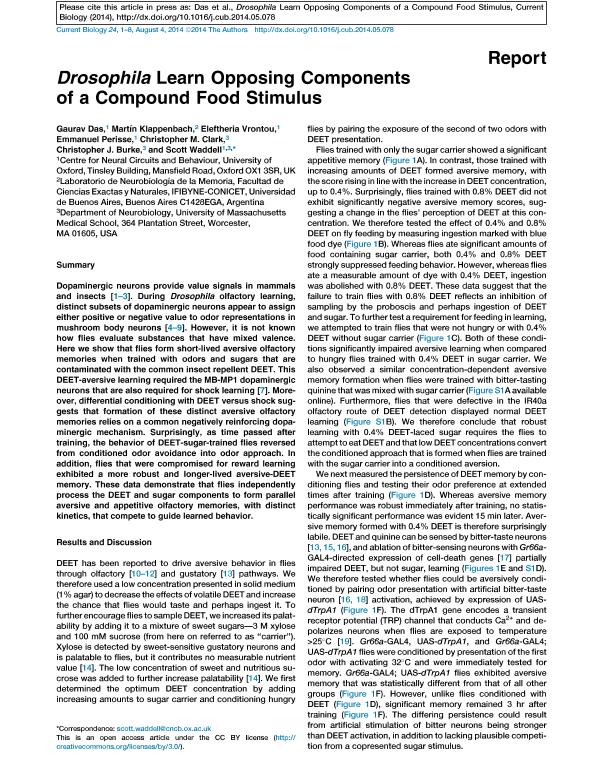Mostrar el registro sencillo del ítem
dc.contributor.author
Das, Gaurav
dc.contributor.author
Klappenbach, Martín

dc.contributor.author
Vrontou, Eleftheria
dc.contributor.author
Persisse, Emmanuel
dc.contributor.author
Clark, Cristopher
dc.contributor.author
Burke, Christopher
dc.contributor.author
Waddell, Scott
dc.date.available
2018-01-03T19:05:09Z
dc.date.issued
2014-07
dc.identifier.citation
Das, Gaurav; Klappenbach, Martín; Persisse, Emmanuel; Vrontou, Eleftheria; Waddell, Scott; Clark, Cristopher; et al.; Drosophila Learn Opposing Components of a Compound Food Stimulus; Cell Press; Current Biology; 24; 15; 7-2014; 1723-1730
dc.identifier.issn
0960-9822
dc.identifier.uri
http://hdl.handle.net/11336/32187
dc.description.abstract
Dopaminergic neurons provide value signals in mammals and insects [1–3]. During Drosophila olfactory learning, distinct subsets of dopaminergic neurons appear to assign either positive or negative value to odor representations in mushroom body neurons [4–9]. However, it is not known how flies evaluate substances that have mixed valence. Here we show that flies form short-lived aversive olfactory memories when trained with odors and sugars that are contaminated with the common insect repellent DEET. This DEET-aversive learning required the MB-MP1 dopaminergic neurons that are also required for shock learning [7]. Moreover, differential conditioning with DEET versus shock suggests that formation of these distinct aversive olfactory memories relies on a common negatively reinforcing dopaminergic mechanism. Surprisingly, as time passed after training, the behavior of DEET-sugar-trained flies reversed from conditioned odor avoidance into odor approach. In addition, flies that were compromised for reward learning exhibited a more robust and longer-lived aversive-DEET memory. These data demonstrate that flies independently process the DEET and sugar components to form parallel aversive and appetitive olfactory memories, with distinct kinetics, that compete to guide learned behavior.
dc.format
application/pdf
dc.language.iso
eng
dc.publisher
Cell Press

dc.rights
info:eu-repo/semantics/openAccess
dc.rights.uri
https://creativecommons.org/licenses/by-nc-sa/2.5/ar/
dc.subject
Drosophila
dc.subject
Memory
dc.subject.classification
Otras Ciencias Biológicas

dc.subject.classification
Ciencias Biológicas

dc.subject.classification
CIENCIAS NATURALES Y EXACTAS

dc.title
Drosophila Learn Opposing Components of a Compound Food Stimulus
dc.type
info:eu-repo/semantics/article
dc.type
info:ar-repo/semantics/artículo
dc.type
info:eu-repo/semantics/publishedVersion
dc.date.updated
2017-12-29T14:21:37Z
dc.journal.volume
24
dc.journal.number
15
dc.journal.pagination
1723-1730
dc.journal.pais
Estados Unidos

dc.description.fil
Fil: Das, Gaurav. University of Oxford; Reino Unido
dc.description.fil
Fil: Klappenbach, Martín. Consejo Nacional de Investigaciones Científicas y Técnicas. Oficina de Coordinación Administrativa Ciudad Universitaria. Instituto de Fisiología, Biología Molecular y Neurociencias. Universidad de Buenos Aires. Facultad de Ciencias Exactas y Naturales. Instituto de Fisiología, Biología Molecular y Neurociencias; Argentina
dc.description.fil
Fil: Vrontou, Eleftheria. University of Oxford; Reino Unido
dc.description.fil
Fil: Persisse, Emmanuel. University of Oxford; Reino Unido
dc.description.fil
Fil: Clark, Cristopher. University of Massachusetts. Medical School; Estados Unidos
dc.description.fil
Fil: Burke, Christopher. University of Massachusetts. Medical School; Estados Unidos
dc.description.fil
Fil: Waddell, Scott. University of Massachusetts. Medical School; Estados Unidos. University of Oxford; Reino Unido
dc.journal.title
Current Biology

dc.relation.alternativeid
info:eu-repo/semantics/altIdentifier/doi/http://dx.doi.org/10.1016/j.cub.2014.05.078
dc.relation.alternativeid
info:eu-repo/semantics/altIdentifier/url/http://www.sciencedirect.com/science/article/pii/S0960982214007787
Archivos asociados
